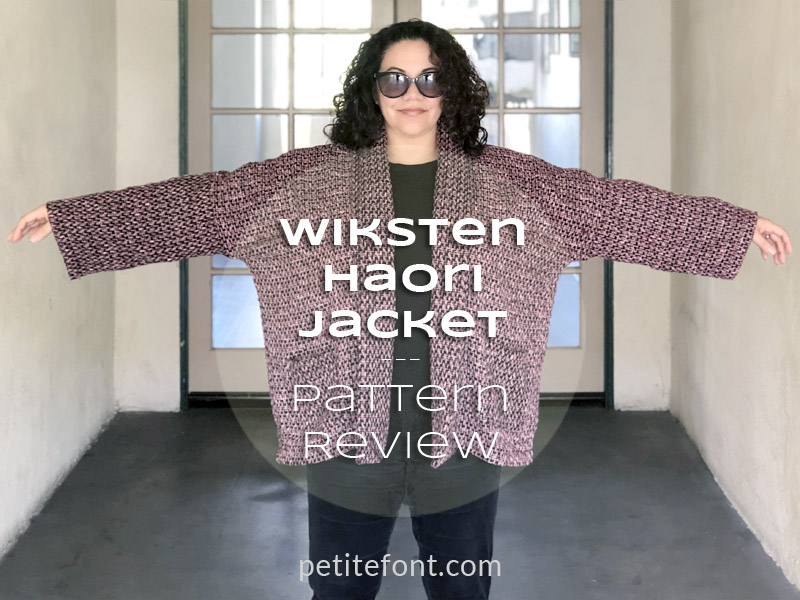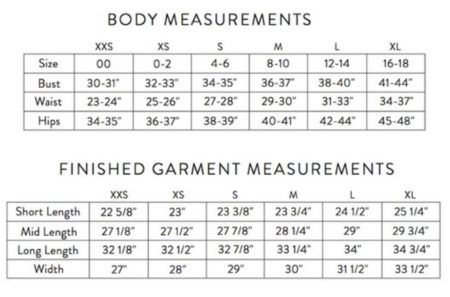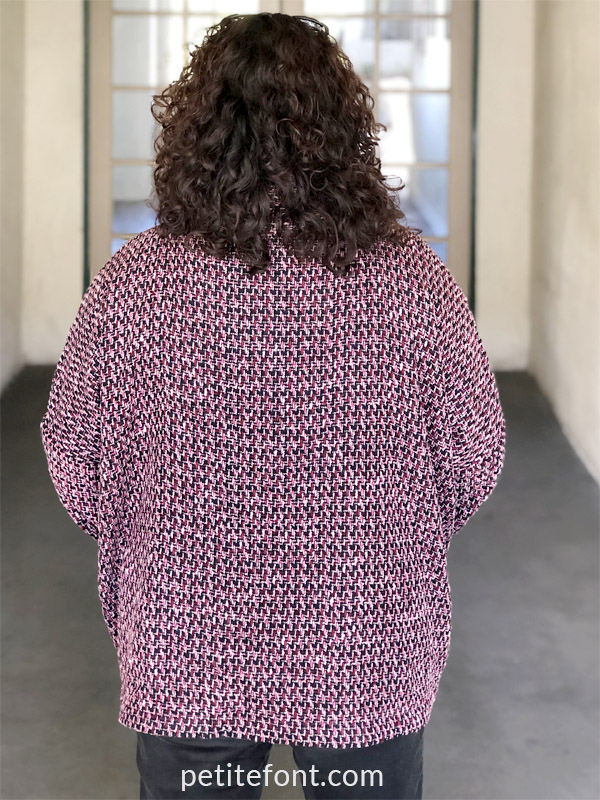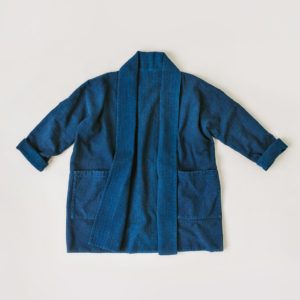This post contains affiliate links. For more information, please see my Disclosure Policy.*

Wiksten recently changed the name of their Kimono Jacket to the Wiksten Haori.
Why? Isn’t it a kimono? No, it isn’t. Even though that is what this style of sleeve is usually referred to as it’s not technically correct. Even if that’s how it’s named in your technical books.
From Wiksten’s own post about the change:
This jacket takes obvious inspiration from the beautiful, historical clothing styles of Japan. It was originally named using the word “Kimono” for a variety of reasons: of course to acknowledge it’s Japanese inspiration, but also in reference to the style of sleeve construction that is widely referred to in pattern drafting books as a “Kimono Sleeve.”¹
However, it has been brought to our attention that such a name was not appropriate for the style of garment. In fact, a “kimono jacket,” the garment worn over the traditional long, belted kimono, is called a Haori. Given the function and style of the pattern, the name Haori is the most appropriate fit for the Wiksten jacket pattern.
They credit Joemy Ito-Gates for bringing this to their attention, and I applaud them for making the change.
In case you’re not aware, Joemy is a teacher and social activist who posts as @little_kotos_closet and was a driving force behind the recent (and ongoing) #10x10representationmatters discussion. It is a campaign to reach more people of color and other under-represented groups to ensure we are included in conversations around fashion.
It’s eye-opening (even for me), and I highly encourage you to take some time with this curated list on the topic from Capsule Closet.
Wiksten Haori
From the pattern description:
A Japanese-inspired jacket. With large pockets and a fold-over collar, this oversized jacket is functional, comfortable, and stylish. Fully lined and reversible (but with pocket on only one side), it looks more complicated to make than it actually is. The design includes three different lengths to choose from—short (hip length), mid (below-hip length), and long (thigh length).
I was inspired to make this by a comment left on my Instagram post about the acrylic boucle suiting I’d received as a gift. This was my first introduction to Wiksten, who only recently started making adult patterns again.
The PDF is $16 which is a lot more money than I usually spend on a single view pattern. Sure it comes with 3 lengths, but there is nothing much different other than the size of the pockets. It’s especially a lot for a pattern company I had never heard of, much less used before. But I did some research on it and was satisfied with what I saw on others to move forward with it.
The cover image reminds me of a Japanese cultural exhibit I worked on many, many moons ago when I was a photo assistant at the UCLA Fowler Museum. Among many of the beautiful artifacts and pieces we photographed for the Matsuri! Japanese Festival Arts exhibit, the ones I remember best are a variety of very old heavy coats used by Japanese firemen in the Meiji period.
Unfortunately, despite being credited in the book, I don’t have permission to share the pictures of the coats. But this one from the Met should give you an idea of the heft and artistry of these garments.
It’s probably the fondness for those memories that led me to jump on this pattern.
Haori Size Chart

The pattern is billed as very roomy, intended to be oversize. Apparently, it was originally a little too roomy and everyone opted to size down, so it was re-released in a slimmer silhouette.
But it’s still very loose!
Wiksten Haori PDF
Here is how the PDF stacks up
- Layered sizes: no
- Colored lines by size: no
- No trim pattern: no
- Prints to edge of paper: no
- Print layout included: yes, page 1 of the pattern file
- A0 available: yes
Not having layered sizes is pretty frustrating. Especially for such an expensive pattern! I think this aspect is basically an expectation for modern PDF patterns at this point, much like indoor plumbing is in our homes.
The pattern lacks notches everywhere except on the collar. By the way, a tip I found during my research phase is that the overcollar and undercollar are the exact same size so there’s no point in printing the piece for the undercollar. This corresponds to pages 1, 8, 15, 22, 29, and 36. That saved me 6 pages of unnecessary ink.
Just don’t forget to cut out 4 of the collar pieces!
Pattern Instructions
The pattern is for a lined jacket, but I wanted an unlined version. (Truthfully, I wanted to be able to take this in if it was too big WITHOUT having to rip out a lining. And having never worked with a weave as loose as boucle, I didn’t know what I was in for.) So even though I mainly ignored the instructions, they are very clear and have great illustrations.
The seam allowance is only 3/8″ which I found to be a little narrow for the thickness of the fabric I was using, so I sewed with 5/8″ seam. Theoretically, that should have made the jacket smaller by 1/4″ at each seam (so a full inch smaller all around).
I was afraid that I was going to have to hand stitch the collar in place, which I had already made up my mind not to do. But the instructions actually call for edge stitching instead of invisible hand stitching. Smart!
Pattern Adjustments
Given how I usually have to shorten garments, I opted for the short version of the Haori in size XL. I then added 2″ to the length as a cheater full-bust adjustment and additional butt coverage.
It’s a good thing I didn’t line it because it is definitely too damn big. Going by the bust size and finished width, I thought this might actually be a bit more fitted (I’m currently a 47″ bust). I did think about sizing down in the shoulders, but I didn’t want to lose any length.

Also because I made this without a lining, I had to figure out a seam finish. I decided on a Hong Kong finish, which means to attach bias binding to each side of an open seam. I cheated a little though. The shoulder and side seams were pressed open and finished separately, but I bound the seams attaching the sleeves to the coat together. It was easier and that much less work.

It looks pretty, too!
The instructions called for lining the pockets, but that was another tip I picked up in my research: don’t. I honestly can’t think of a good reason to, even with my kooky loose weave fabric. I’m all about less work.
I did want the pockets to fit my super-sized iPhone but didn’t want them to be as big as the large pockets that are included. (There is a large pocket for the medium and long lengths, the shorter length has a smaller pocket.) I lengthened them just 1″ and added to the seam allowance to give me a 5/8″ seam all the way around.
But because I added length to the front too, I had to figure out where to put the pockets so they were functional. I pinned them on at the original mark, then after putting on the half-made jacket, moved them down about 1.5″.
The fabric was maddening to work with. It didn’t just fray—it completely unraveled! I staystitched all the edges to keep the weave from coming completely undone, but oh Mylanta! I still pulled a bunch of loose yarns (not thread—yarn!) out in frustration. I now know why Chanel jackets are so incredibly expensive. Yes, I know they are made with the highest level of couture techniques, but this loose weave has the power to drive a person insane. I’m not sure I’ll ever work with it again, for any money, even though I have a full yard plus leftover.
Final Thoughts
I don’t love the finished piece. It looks pretty on Dorie, and the inside is so nicely done with my bubblegum pink bias tape. But overall it’s just too big. I don’t like how it makes me look bigger than I really am.
The fabric choice was rather dubious, too. The individual yarns of the weave keep snagging and I’m just afraid of damaging it if I wear it out of the house. Inside the house is fine, but when I sit at my desk the oversized sleeves catch on arms of my chair.
Aside from being too large overall, I don’t love how it hangs on me. The back pulls up in the middle, indicating I probably should have done a high round back adjustment. This would help the hem hang parallel to the ground in the back without pulling the shoulders back with it.


Overall I think it just makes me look fatter.
On the Wiksten blog there’s a version for a curvier woman (also sans lining!), whose bust and waist measurements are smaller than mine. I don’t know what adjustments were made for her, but it’s much more flattering on her than on me. There are only 2 photos though, so maybe we aren’t seeing the whole picture. #pun
But I’m dismayed that this is such an expensive buy for what is a pretty simple pattern. $16 is a lot of money, especially for a pattern that doesn’t have any advanced techniques beyond a lining. There aren’t any closures or even a waist tie, so nothing tricky other than ensuring the sleeves seams match up. It’s one of the simplest and yet still most expensive patterns I own. I’m pretty pissed at myself for that.
For comparison, the Cashmerette Chilton trench coat pattern is the same price for the PDF ($20 for the paper pattern) but is much more advanced. It has princess seams, a back yoke/cape, 2-piece sleeves AND collar, waist tie, button front, epaulettes, and flap pockets. Plus Cashmerette patterns come with built-in cup sizes!
I do, however, commend Wiksten for being culturally sensitive and changing the name. Kudos for being open to the conversation!
I’m sure the problems I’m having with the coat are of my own making. I’m going to take it to my next ASG meeting and see if the veteran seamstresses can help me fix it. So there is still hope for this garment!
Till then, this will live on Dorie.
At least this qualifies for both the Sew Alongs #coatalong and Curvy Sewing Collective #curvyyearofsewing, so yay?






It’s a shame that you don’t love the finished result. I think it looks beautiful!
Thanks Josy. It’s just too big. With some work, it might look better. We’ll see!
Looks great! It is summer where I live at the moment but I would definitely give this a go at making it during winter if I could overcome the problems with the pattern. Visiting from Sharing,Inspiring, Promoting.
Summer kimonos are fabulous! I would highly recommend the Helen’s Closet Suki, which can also be used as a robe. It’s slightly less expensive but with better fit (and a sew along!).
Thanks for an honest review; I also find many patterns to be fairly expensive, so it’s really helpful to know what I’d be getting.
You’re welcome! I have seen a few more versions of this floating around Instagram since I made this post, and they seem to have worked out well for others. You just really need to like oversized looks, I guess?
Really appreciated your honest review of the pattern, price point too & being a PDF. I’ve made haori from local Hawaii patterns (more Japanese American influences there) and there is also Folkwear. I loved your tie in from the Met too. Mahalo!
I’m glad you found it helpful, Lonnie!
Thank you for making and talking about this pattern. I love the design and was considering forking out the big bucks for it but now I won’t. I will design my own! And I will definitely being using your taped seams idea. It looked AMAZING! 🙂
Thank you, Suze! I think if you have any amount of design knowledge, it shouldn’t be too hard to draft this yourself. Best of luck and let me know when you make it! I’d love to see it.